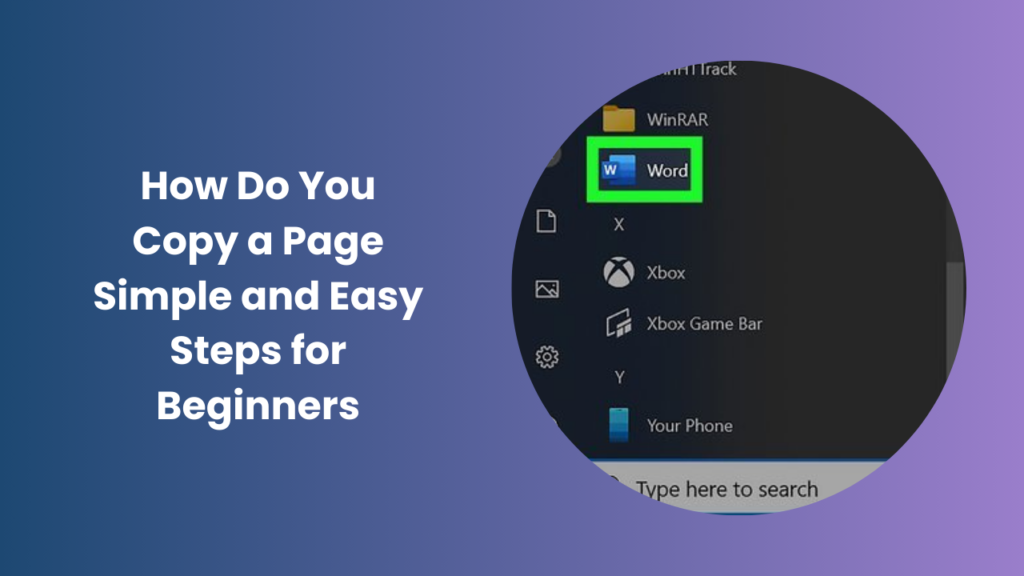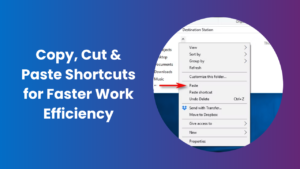Copying a page may seem like a simple task at first glance, but when you are working with documents, websites, or design tools, the process is more meaningful than it appears. Whether you are creating web content, editing professional reports, or designing visual layouts, the ability to duplicate existing work correctly saves time and ensures consistency. For beginners, the most common question is, how do you copy a page without losing formatting, structure, or quality? Understanding this not only improves your efficiency but also helps you avoid errors that often occur when content is recreated manually.
Consider the example of professional documents. A carefully formatted report with tables, charts, and styled headings can take hours to prepare. If you need to create another report with the same structure, starting over from scratch would not only be time-consuming but also prone to inconsistencies.
Why Copying Pages is More Important Than You Think
Many professionals underestimate the role of page duplication. Students often copy pages in assignments to preserve formatting, while office workers use it to prepare multiple reports with a uniform layout. Content creators, on the other hand, rely heavily on duplication to maintain brand identity across websites, blogs, and e-books. This simple action has a direct impact on productivity. Without knowing the right way to copy a page, people often waste valuable time rebuilding layouts that could have been duplicated in seconds.
Copying also plays an important role in consistency. If you are managing a large website or publishing an e-book with multiple chapters, every page should follow the same structure. Without duplication, it becomes difficult to maintain uniformity in fonts, headings, spacing, and formatting. Copying a page ensures that every section of your work feels professional, aligned, and well-organized.
How Do You Copy a Page in Different Platforms
The methods of copying a page vary depending on the platform you are working on. Word processors, content management systems, and design software each have their own techniques. The goal remains the same: to replicate existing work in a way that saves time, preserves formatting, and allows flexibility.
Copying Pages in Word Processors
When working in tools like Microsoft Word or Google Docs, copying a page involves highlighting the entire content and using the copy-paste function. However, this task is more than just pressing a shortcut key. For proper duplication, you need to pay attention to hidden formatting such as headers, footers, page numbers, and tables. In Word, section breaks often control how content is displayed across pages, so copying without them can disrupt the structure. Similarly, in Google Docs, spacing and alignment may shift if the copied content is not adjusted carefully. The efficiency of duplication lies in how well you preserve these formatting details.
Copying Pages in Content Management Systems
If you run a website using a CMS like WordPress, duplicating pages becomes essential for building a consistent site. For example, if you have created a blog post layout with specific headings, featured images, and SEO settings, you can copy that page instead of recreating the design. WordPress provides built-in features as well as third-party plugins that allow duplication with one click. This is especially helpful when you are publishing multiple posts with similar structures but different content.
Content duplication in CMS platforms is not just about speed it also plays a role in branding. Websites often require multiple landing pages that share the same layout but target different services or products. Copying pages ensures that the branding elements remain identical while the content can be customized for each purpose.
Copying Pages in Design Tools
In the world of design, duplication has a creative purpose. Tools like Canva, Figma, and Adobe Illustrator allow designers to copy entire pages or artboards to test variations of a design. Instead of re-creating a visual layout, you can duplicate a page and make small changes such as adjusting colors, text, or images. This makes experimentation easier and allows you to compare multiple versions side by side.
For businesses, this approach ensures brand consistency. Marketing materials such as brochures, flyers, and presentations often require multiple versions of the same template. By copying a page, you maintain professional quality while tailoring each version to a specific audience.
Advantages of Copying a Page
Copying a page is not just a shortcut, it is a strategic step that offers several professional advantages.
One major benefit is time-saving. In fast-paced environments, every minute counts. Instead of manually formatting content again and again, duplication gives you a ready-made structure in seconds. This saved time can then be used for refining content or improving design.
Consistency is another significant advantage. Uniformity in design and structure builds trust among readers and clients. A report that looks the same from start to finish appears more professional, while a website with consistent layouts makes navigation easier for visitors.
Copying also minimizes human error. Manual recreation often leads to missing details or misaligned elements, while duplication ensures that everything is transferred exactly as it was.
Challenges and Mistakes in Copying a Page
Although the process seems straightforward, there are challenges that users often face. One of the most common mistakes is over-reliance on duplication without proper customization. When every copied page looks identical and lacks originality, it reduces engagement and may even hurt SEO if published online.
Another mistake is forgetting to update important details. For instance, copied reports may still carry old dates, page numbers, or references. Similarly, in website content, forgetting to change metadata or keywords may result in duplicate content penalties.
Practical Tips for Effective Page Duplication
Successful duplication requires a balance between efficiency and customization. After copying a page, you should always make adjustments to suit the new context. This could mean rewriting sections of text, changing titles, or updating design elements.
For web content, pay special attention to SEO. Even if the layout remains the same, each page must have unique titles, meta descriptions, and keywords to perform well in search results. In academic or professional documents, ensure that references, figures, and data are updated in the copied pages to reflect the most recent information.
FAQs
Can I copy a page without losing formatting?
Yes, but it depends on the platform. In Word and Google Docs, proper selection ensures formatting remains intact. In CMS platforms, plugins are often used to preserve both layout and metadata.
Is copying a page bad for SEO?
Copying the layout is fine, but duplicating content without making changes can harm your SEO. Always ensure the text is unique, even if the page structure is duplicated.
Why do designers often copy pages instead of starting fresh?
Designers copy pages to maintain brand consistency and save time. By working on duplicated layouts, they can test creative variations while keeping a uniform style.
How is copying a page useful in education?
Students often use page duplication to maintain consistent formatting in assignments, essays, or projects. It reduces the effort of rebuilding tables, headers, and references repeatedly.
Conclusion
In today’s digital landscape, learning how do you copy a page is more than just a technical skill; it is a strategy for efficiency, consistency, and accuracy. From word processors and CMS platforms to design software, the ability to duplicate work correctly ensures that you save time, reduce errors, and maintain professional standards. The key is to treat copied pages as starting points, not finished products. By customizing content, updating details, and adapting layouts, you can transform duplicated pages into valuable assets. Whether you are a student, a business professional, or a creative designer, mastering the art of page duplication will give you greater control over your projects and make your workflow significantly more effective.





